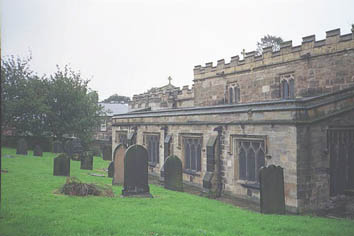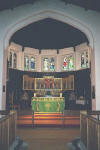|
Mexborough St John The Baptist
A History of Mexborough
Home

Mexborough
is a dormitory, market town, situated on the banks of Rivers Dearne and Don. In
the past it was a thriving, bustling, industrial town.
The first
sizeable influx of people was the navvies and watermen, who came to Mexborough
when the company of cutlers in Sheffield petitioned Parliament in 1722 to make
the River Don navigable. The river at this point needed to be deepened and a
canal dug between Kilnhurst and a point near to Mexborough church. By 1751
craft could get from Tinsley to Hull and therefore trade could take place with
the outside world. Then in 1804 the Dearne and Dove canal was opened, giving
access to vast coal deposits of the Barnsley area. The canal remained until
recently a main industry and many families who descend from canal workers can
still be found in the town.
 The
first industry to take advantage of the abundance of coal and the new mode of
transport, was the pottery trade, and several potteries grew up in and around
Mexborough. All of these potteries imported their skilled workers from old
pottery areas, mainly Staffordshire. The
first industry to take advantage of the abundance of coal and the new mode of
transport, was the pottery trade, and several potteries grew up in and around
Mexborough. All of these potteries imported their skilled workers from old
pottery areas, mainly Staffordshire.
The
existing rout of the River Don was abandoned in 1834 and a canal dug. Then in
1839 the railway arrived, with the first station being in Swinton. The
following year, this was followed by the Conisbrough – Swinton branch of the
Doncaster – Tinsley Turnpike. Then in 1849 came the railway, which passes
through Mexborough to Doncaster. All these improvements in communications
needed people brought in from other areas, firstly, to assist in their
construct, and later to run them.
During the
19th century the glass workers followed the industrial potters from
Lancashire. In c1850 the Barron family arrived from Lancashire accompanied by
four friends and began the Don Glassworks. Later the friends broke away to
create their own glassworks at Swinton. Then Caleb Kilner arrived and by the
turn of the 20th century there were at least four glassworks in and
around Mexborough. These brought many people to Mexborough, but this was
nothing compared to the ten – fold increase brought about by the sinking of the
Denaby Colliery (1863) and Manvers Main colliery (1868). So many workers came
to Mexborough that the housing, overcrowded as it was, couldn’t cope, and many
initially lived in tents. These pits were the start, and Mexborough, and its
people, became dependent on the pits for its economy.
 Many
drownings took place in Mexborough. Children would swim, during the hot
summer months; at a weir close to the ferry, and at Devil’s Elbow on the River
Don. Devil’s Elbow, which is situated behind Mexborough Station, is a
particularly dangerous place to swim, it looks so still and inviting on a hot
day, but underneath there is a treacherous current, which has dragged under the
strongest of swimmers. Another place favoured by the children and adults
alike was the ‘Lido’ on the river Dearne. This has a sandy, beach like
area, with shallows for the smaller children to paddle in, but part of the river
close by was extremely deep and young men diving in would get entangled in the
roots of trees etc. and drowned. Many
drownings took place in Mexborough. Children would swim, during the hot
summer months; at a weir close to the ferry, and at Devil’s Elbow on the River
Don. Devil’s Elbow, which is situated behind Mexborough Station, is a
particularly dangerous place to swim, it looks so still and inviting on a hot
day, but underneath there is a treacherous current, which has dragged under the
strongest of swimmers. Another place favoured by the children and adults
alike was the ‘Lido’ on the river Dearne. This has a sandy, beach like
area, with shallows for the smaller children to paddle in, but part of the river
close by was extremely deep and young men diving in would get entangled in the
roots of trees etc. and drowned.
Whereas there seems to be
many deaths, which have been the result of drownings, deaths by cholera are
conspicuous by their absence. The industrial cities and towns in close
proximity to Mexborough were badly hit, notably Sheffield where in July 1832 an
outbreak of plague proportions hit the city. Hundreds of barges travelled
daily through Mexborough to and from all the industrial towns and cities
affected by cholera, so by 1849, why did Mexborough stand alone by having only
one gravestone standing in its churchyard to a victim of this terrible disease?
The answer was that Mexborough had a fastidious vicar who set down many rules to
safeguard his congregation. He ordered that no person who had come from, or
travelled through an affected area should be allowed to alight from the barge;
that no person from an affected area should be allowed to enter Mexborough.
Visiting people in affected areas was discouraged; lastly the banks of the canal
passing through the town were covered by quick lime. All the rules set
down had to be
strictly
adhered to.
WHOLERS
AND HELFERS
In 1633 a Terrier
was taken of Mexborough and the parish clerk made some interesting notes:
“Wholers
and Halfers. The inhabitants of Swinton are partly wholers and partly halfers
to the Churches or Parsonages of Wath and Mexborough. Wholers are that they pay
their tythes wholey both procedial and personal to one of the fore saide
churches only, viz., to Wath or Mexborough only.
Halfers are
they that pay their procedial tythes half to one of the fore saide churches and
half to the other every year, but resort one yeare to Wath Church and the next
yeare following to Mexborough Church, personally, and pay personal tythes and
doe personal duties one yeare at one church and the next yeare following to the
other church..”
In short this
means that the people of Swinton would attend Mexborough Church where they were
baptised, married, or buried and pay the tythe taxes. Then the following year
they would attend Wath Church, where they would be baptised, married, or buried.
The parish clerk
then goes on to name some of the residents of Swinton who had been allocated a
seat in Mexborough Church and what seat they had been given.
NOTE:
The registers for Swinton
church begin in 1817, so if your ancestors lived in Swinton prior to that date,
don’t forget to look in both Mexborough and Wath registers, not forgetting the
contents of both parish chests.
Back to Churches
| 